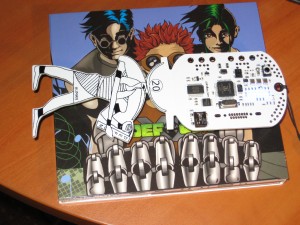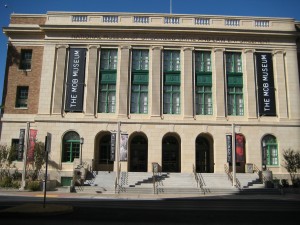I got in line for my badge around 7:30 AM. Registration opened at 8 AM, according to the schedule.
I got my badge at 9:30 AM. I have no idea how many people were in line, but it was packed. We were told that folks started camping out for badges at 10:30 PM Wednesday night.
But, hey! I got mine!
After what was (in my opinion) last year’s badge fail, they went back to an electronic badge this year, still tied in to a “crypto-mystery” game, but at least the badge does something useful.
Or perhaps can do something useful, would be a better way of putting it. The designer calls it a “development platform”: there’s holes for I/O pins at the top, and we were issued VGA (1) and PS/2 connectors (2) with the badge to attach ourselves. And remember my inquiry a while back about microcontrollers? The badge CPU is a Parallax Propeller.
(I haven’t been able to get the badge and Project E talking yet. I suspect a bad or wrong USB cable.)
I hit two panels today. Worth noting is that today’s theme was “DEFCON 101”: there was only one programming track, and the theme of those items was more “introduction to” rather than “deep dive.”
DaKahuna’s “Wireless Security: Breaking Wireless Encryption Keys” wasn’t quite what I expected, in that he didn’t do a live demo. (Though he did suggest that there would be systems available for practice in the Wireless Village.) Rather, this was something of a “view from 10,000 feet” presentation, giving a basic introduction to hardware requirements and tools for attacking wireless keys, along with explanations of how WEP and WPA keys work, and where the vulnerabilities are. A lot of this stuff I already knew from my academic studies, but then again, I wasn’t the target audience here, and I did pick up a few tips.
The presenters for “Intro to Digital Forensics: Tools and Tactics” sold me in the first five minutes by pointing out that:
- Not everyone knows everything.
- It would behoove the community to stop acting like dicks when people ask reasonable questions, like “What switches should I use for NMap?”.
The presenters then proceeded to give example usages for what they considered to be the top five tools for testing and exploration:
- The Metasploit framework, which they sadly ran out of time while discussing.
- Ntop, the network traffic analyzer.
- Nmap, for doing port scans and OS fingerprinting. For example:
#nmap -v -sT -F -A -oG 10.x.x.x/24
What does this mean?
-v turns on verbose mode
-sT forces NMap to do a full TCP connection to each host
-F enables fast scan mode
-A tells NMap to do OS fingerprinting
-oG tells NMap to output in a format grep can work with,
10.x.x.x/24 tells NMap the range of hosts to scan. - tcpdump, which captures packets on a given network interface.
tcpdump -i eth1 -n -x
-i specifies the interface
-n turns off /etc/services translation, so instead of displaying the service name (ftp, telnet, etc.) it just shows the port number.
-x dumps hex output to the screen - Netcat, which creates TCP sockets that can be used for communications between systems. But that’s a little misleading. Let’s say we have two systems, our localhost and a machine at 192.168.1.128. On the .128 machine, we run:
nc -l -p 2800 -e cmd.exe
-l tells netcat to listen for a connection
-p tells netcat to listen for that connection on port 2800
-e tells netcat to run a command when a connection is made on that port: in this case, netcat will run cmd.exe.
On the local system:
nc 192.168.1.128 2800 connect
which establishes a connection between our system and the remote system. The remote system will run cmd.exe, which (on a Windows system) should give us a command shell on the remote system that we can use from our localhost.
I took the rest of the day off to visit a couple of bookstores (both are still there, pretty much unchanged) and the Mob Museum.
My first thought was that $18 seems a bit stiff. Then again, the Atomic Testing Museum is $14, And the Mob Museum seems to have more people on staff, and may possibly be a little larger than the ATM. (I can’t tell for sure, but the Mob Musuem bascially has that entire building: all three floors.) ($5 for parking cheesed me off a bit, though.)
Anyway, while the Atomic Testing Museum is still my favorite Vegas musuem, the Mob Museum is well worth visiting, especially if you have an interest in organized crime in the United States. (Not just in Vegas, though that is a key focus; the museum also talks about organized crime in other areas, including NYC and Cleveland.) There is a lot of emphasis on Estes Kefauver, perhaps just a little more than I thought was warranted.(I admit, I chuckled at the “Oscar Goodman” display.)
Two things that surprised me:
- The number of families with small children at the Mob Museum. Parents, would you take your kids to a museum devoted to organized crime? (There’s some pretty graphic stuff, but the Museum confines it all to one section, warns you before you enter the section, and gives you an option to skip past it.) (And I feel kind of hypocritical saying this: if my parents had taken me to the Mob Museum when I was, say, 10, wild horses couldn’t have dragged me out of there.)
- The popularity among small children of the firearms simulator. Kids were having a lot of fun pretending to be cops, running through various scenarios (like a domestic dispute) and busting caps in bad guys. (I didn’t tell any of the kids that, had they actually been out on the street, they’d be dead before they got their first shot off. Do I look like an asshole?)
Tomorrow is when things start for real. Look for an update, but probably late in the evening.
(Oh, I did want to mention Chad Everett’s death yesterday, but I was using the Kindle to blog, which was a pain, and things got kind of sideways leaving LAX and arriving in Vegas, so consider this your obit watch.)

